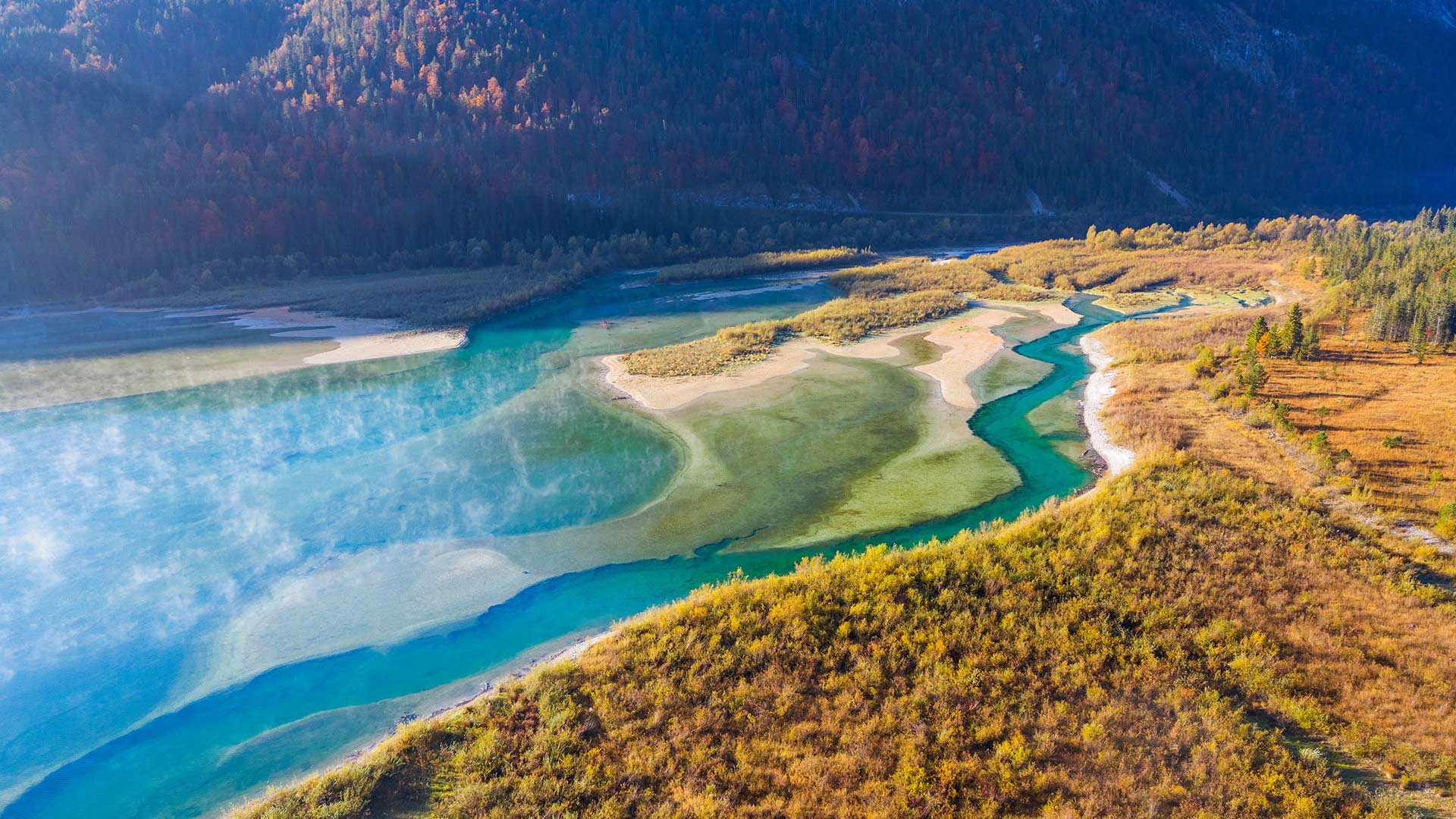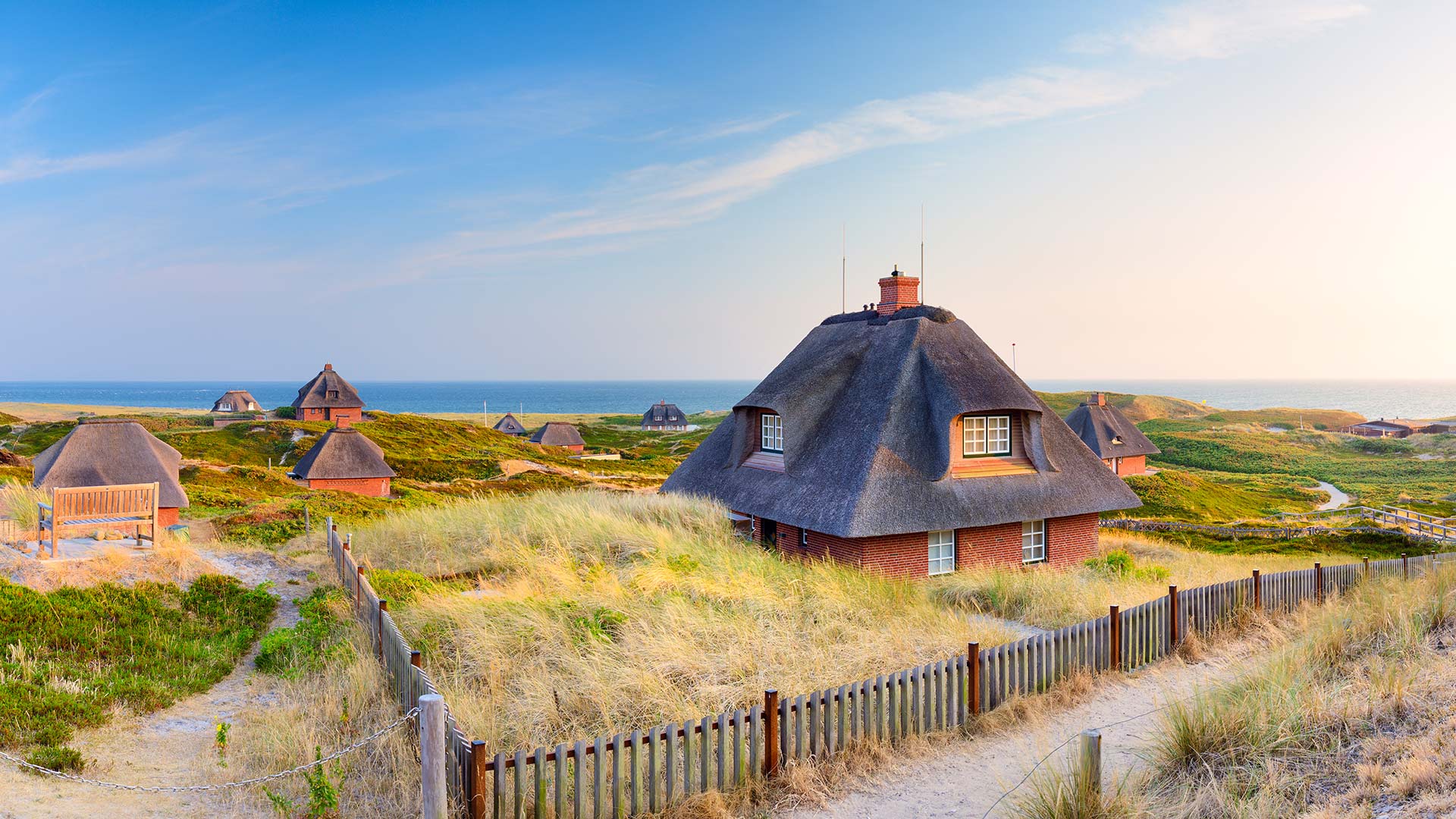菲希特尔山脉上的和平钟,萨克森州,德国 Peace bell on the summit of Fichtelberg, Saxony, Germany (© Jan Drahokoupil/Getty Images)
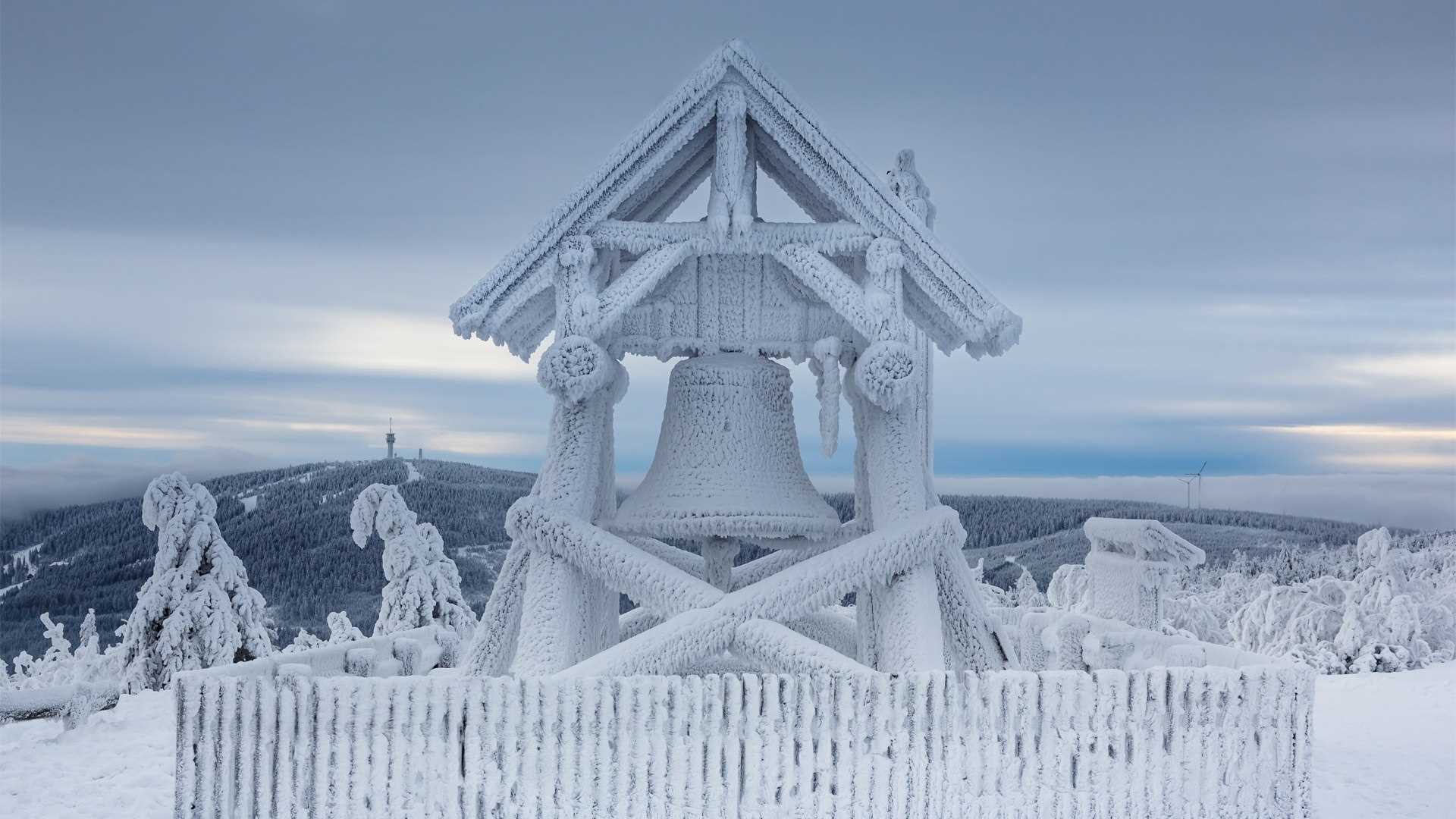
菲希特尔山脉上的和平钟,萨克森州,德国 Peace bell on the summit of Fichtelberg, Saxony, Germany (© Jan Drahokoupil/Getty Images)
和平之钟 A bell for peace
菲希特尔山脉,德国萨克森州
菲希特尔山位于厄尔士山脉的上维森塔尔镇附近。这座山高1214米,是东德最高的山峰,也是冬季运动爱好者的圣地。这里有各种冬季运动,双板滑雪、单板滑雪、越野滑雪、雪橇雪橇和马拉雪橇等等。如果你更喜欢夏天,也可以在这里来场夏日旅行,体验这里的自然风景。在菲希特尔山顶有一座和平钟,在这里欣赏到周围群山的壮丽景色。
Peace bell on Fichtelberg, Germany
The Fichtelberg is located on the Oberwiesenthal in the Ore Mountains. This mountain is 1214 m high, making it not only the highest mountain in East Germany but also a very prestigious place for winter sports enthusiasts. All kinds of sports are offered. From classic skiing and snowboarding to cross-country skiing, cross-country skiing tours, tobogganing, and horse-drawn sleigh rides. If you prefer summer, you can also enjoy this place in the warm season and completely immerse yourself in untouched nature. At the top of the mountain, you can visit the Fichtelberghaus. From there you have a breathtaking view of the surrounding mountains.
霍亨索伦城堡,德国 Hohenzollern Castle, Germany (© Sahara Prince/Shutterstock)
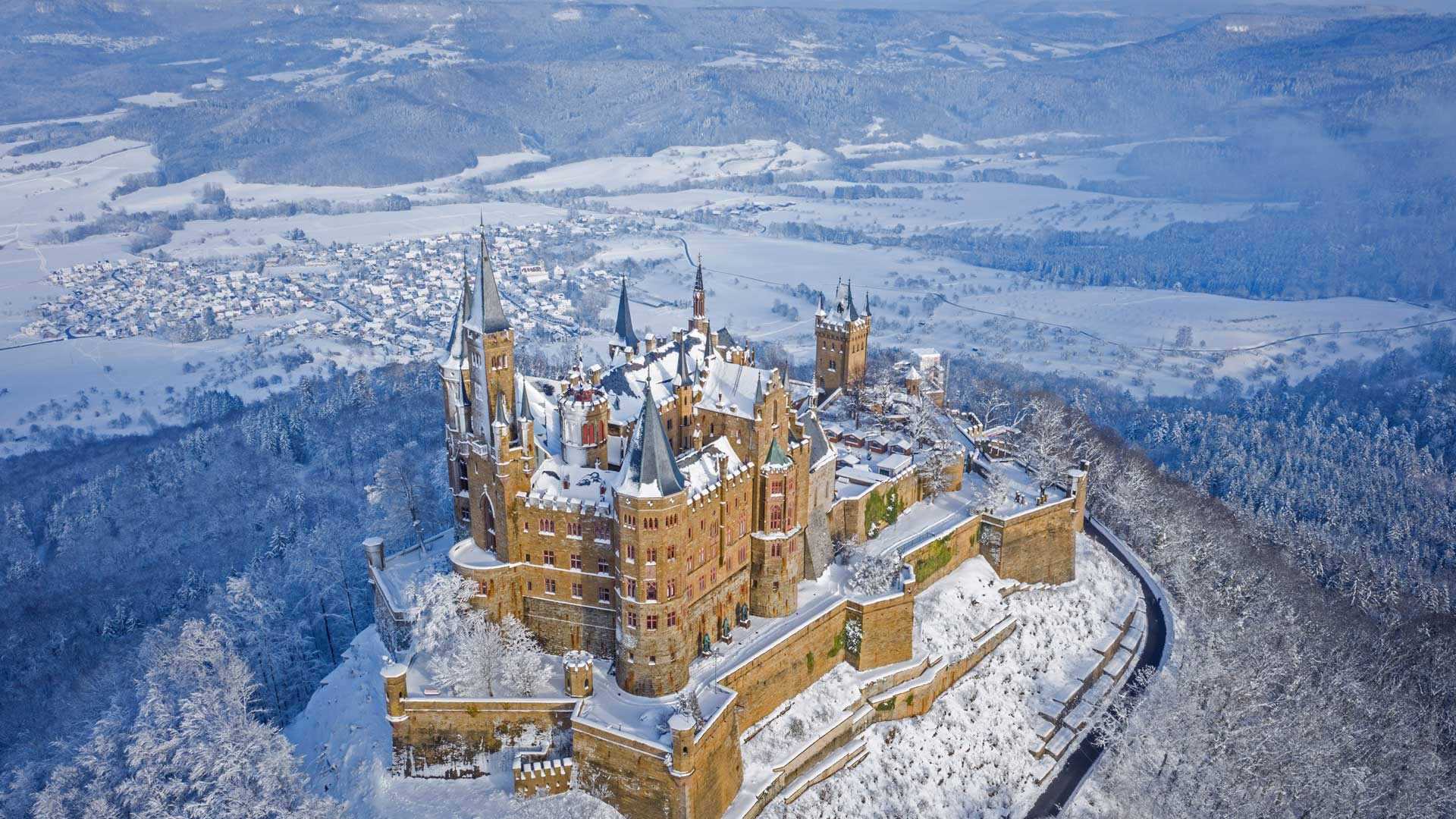
霍亨索伦城堡,德国 Hohenzollern Castle, Germany (© Sahara Prince/Shutterstock)
正如童话一般 Fit for a fairytale
德国斯图加特附近的霍亨索伦城堡
迷人的霍亨索伦城堡经过三次重建后,是真的魅力非凡。这座城堡位于霍亨索伦山顶,修建于11世纪,但大部分建筑在1423年长达10个月的围攻中被摧毁,直到几十年后才得以重建。之后它成为了一个重要的战略据点,然而后来它再次失修。19世纪,普鲁士国王腓特烈·威廉四世(他因在德国各地建造了许多伟大的建筑而闻名)在这里建造了一座新的城堡,几乎完全替换了这座城堡15世纪的建筑结构。如今,霍亨索伦城堡已成为一座露天博物馆,每年接待超过35万名游客,是德国参观人数最多的城堡之一。
Hohenzollern Castle near Stuttgart, Germany
For the charming Hohenzollern Castle, the third time really was the charm. Constructed on the top of Hohenzollern Mountain in the 11th century, the castle was largely ruined by a 10-month siege in 1423, only to be rebuilt a few decades later. It then served as an important strategic stronghold before again falling into disrepair. In the 19th century, King Frederick William IV of Prussia, best remembered for his commitment to building great works across Germany, had a new castle built on the grounds, replacing almost all the 15th-century construction. Today, Hohenzollern Castle is an open-air museum that hosts more than 350,000 visitors per year, making it one of the most-visited castles in Germany.
泰根塞山脉Roßstein山顶的景色,德国巴伐利亚州 View from the summit of Roßstein mountain, Bavaria, Germany (© Christian Bäck/eStock Photo)
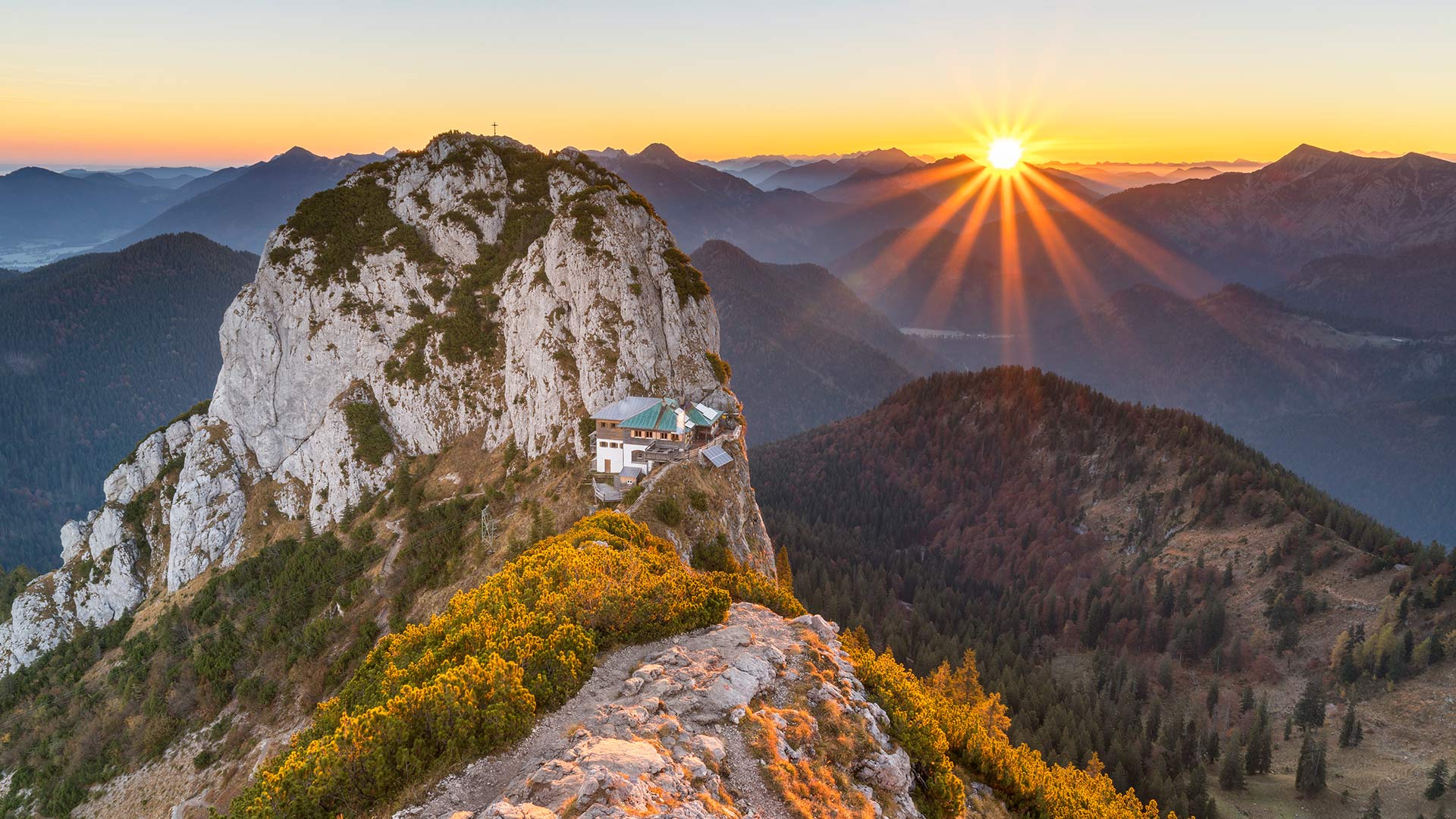
泰根塞山脉Roßstein山顶的景色,德国巴伐利亚州 View from the summit of Roßstein mountain, Bavaria, Germany (© Christian Bäck/eStock Photo)
国际山岳日 International Mountain Day
特根塞山脉
山脉是我们世界上最有趣的地质特征之一。山脉也成为无数代人类的游乐场和崇拜场所,这清楚地证明了地球表面下发生的巨大变化。几千年来,任何对如此多的人和文化如此重要的东西都值得纪念。因此,在12月11日,我们庆祝国际山地日!
我们的旅程将带我们前往位于特根塞山脉的上巴伐利亚州,这是一个属于巴伐利亚前阿尔卑斯山脉的山区。这张照片显示了从罗ß斯坦河(1698米)到布赫斯坦河(1701米)的景色。这两座山形成了一座双峰,泰格恩塞·吕特(Tegernsee Hütte)就坐落在它的马鞍上。该避难所于5月中旬至11月初开放,为徒步旅行者和登山者提供食宿。由于其暴露的位置,其位置通常被称为“鹰巢”。
Tegernsee Mountains
Mountains are some of the most interesting geological features that our world has to offer. Clear proof of the massive changes that happen beneath the surface of our planet, mountains have also served as playgrounds and places of worship for countless generations of humans. Anything that’s been such a mainstay for so many people and cultures through millennia is worth commemorating. So on December 11, we celebrate International Mountain Day!
Our excursion takes us to Upper Bavaria in the Tegernsee Mountains, a mountain region that belongs to the Bavarian Pre-Alps. The photo shows the view from the Roßstein (1,698 meters) to the Buchstein (1,701 meters). Both mountains form a double peak, in whose saddle the Tegernsee Hütte nestles. The refuge, which is open from mid-May to early November, offers board and lodging to hikers and climbers. Due to its exposed location, its location is often referred to as the "eagle's nest".
坎彭万德山,基姆高地区阿绍,德国巴伐利亚州 View from Kampenwand mountain, Aschau im Chiemgau, Bavaria, Germany (© Toni Anzenberger/plainpicture)
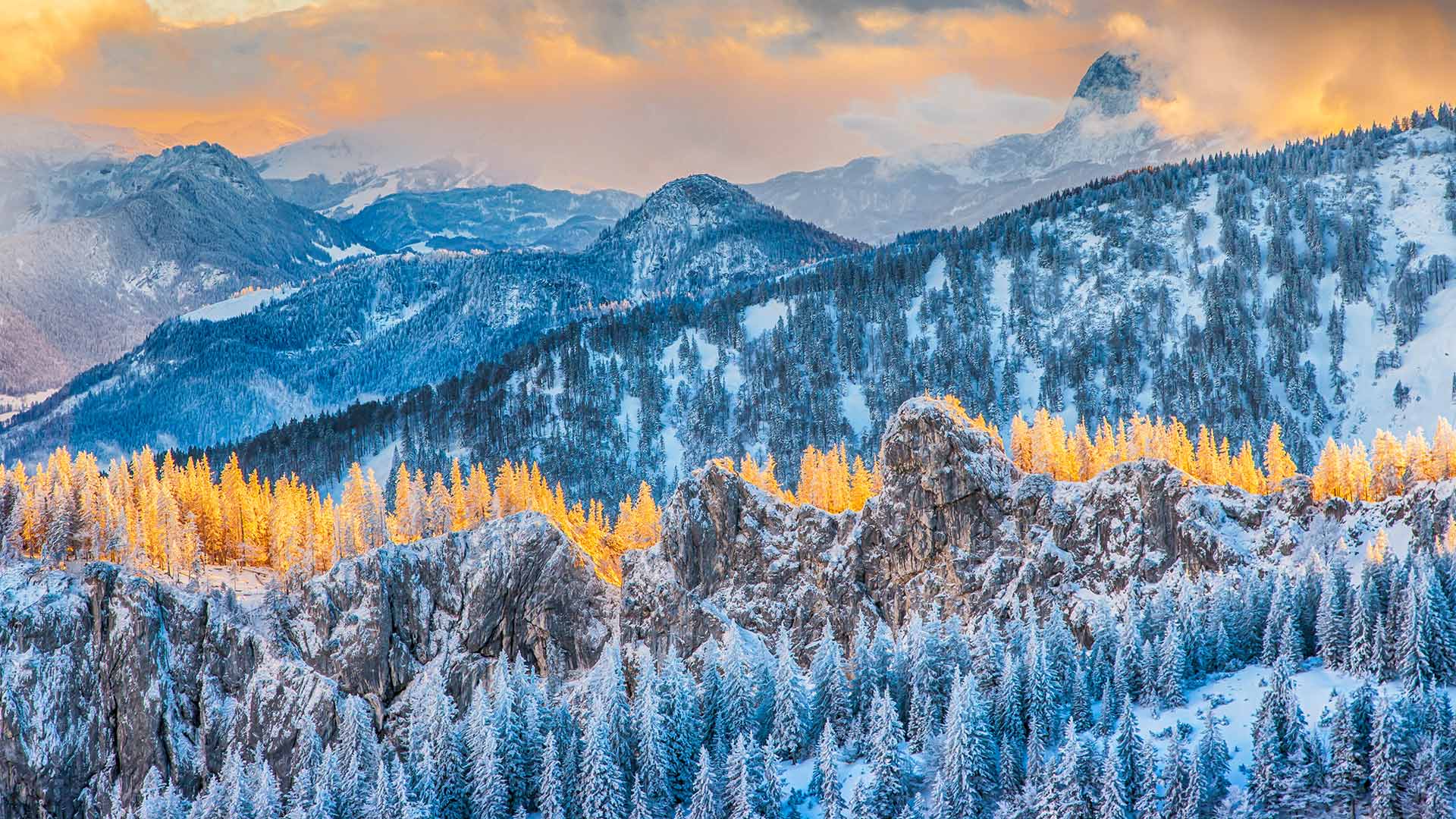
坎彭万德山,基姆高地区阿绍,德国巴伐利亚州 View from Kampenwand mountain, Aschau im Chiemgau, Bavaria, Germany (© Toni Anzenberger/plainpicture)
令人惊叹的山顶美景 Stunning mountain top view
巴伐利亚州坎本万德山
冬天已经来到了坎彭德的顶峰。在春季和夏季,许多徒步旅行者、山地自行车手、登山者、悬挂滑翔机和滑翔伞爱好者在这里嬉戏,在寒冷的季节,一点平静逐渐回归。现在,该地区正成为雪鞋徒步旅行者和滑雪旅游者的吸引力。
根据观看方向的不同,您可以欣赏坎彭德的壮丽全景。阿尔卑斯山麓和基姆山脉向北延伸,在晴朗的日子,你甚至可以看到西北部的慕尼黑电视塔。在南部-如这张照片中所示-可以看到巴伐利亚和奥地利山脉的独特景色。
Kampenwand mountain, Bavaria
Winter has already arrived at the summit of the Kampenwand. Where numerous hikers, mountain bikers, and climbers as well as hang-gliders, and paragliders cavort in spring and summer, a little calm gradually returns in the cold season. Now the region is becoming an attractive attraction for snowshoe hikers and touring skiers.
Depending on the viewing direction, you can enjoy a magnificent panorama from the Kampenwand. The foothills of the Alps with the Chiemsee stretch northwards, and on a clear day, you can even spot Munich's television tower in the northwest. In the south - as in this photo - there is a unique view of the Bavarian and Austrian mountains.
伊萨尔河鸟瞰图,德国伦格里斯 (© Martin Siepmann/Offset/Shutterstock)
玛利恩堡,德国莱茵兰-普法尔茨州采尔县附近 Marienburg near Zell, Rhineland-Palatinate, Germany (© Eiben, Hans Georg/Alamy)

玛利恩堡,德国莱茵兰-普法尔茨州采尔县附近 Marienburg near Zell, Rhineland-Palatinate, Germany (© Eiben, Hans Georg/Alamy)
维尔茨堡美因河畔的一座城堡 Riverside castle
莱茵兰-帕拉蒂纳州马里恩堡
马里恩堡是德国维尔茨堡市美因河畔的一座城堡。它是维尔茨堡的象征,近5个世纪以来一直是王子和主教的故乡。它自古以来就是一座要塞。1631年,瑞典古斯塔夫二世阿道夫(Gustav II Adolf)征服该地区后,城堡被重建为巴洛克式要塞。今天,它是一个公园和博物馆。
Marienburg, Rhineland-Palatinate
Marienburg is a castle on the River Main in Wurzburg, Germany. It is the symbol of Wurzburg and has been the home of princes and bishops for nearly 5 centuries. It has been a fortress since ancient times. After Gustav II Adolf of Sweden conquered the area in 1631, the castle was rebuilt as a Baroque fortress. Today, it is a park and museum.
秋天的图林根森林与瓦特堡城堡,德国 Thuringian Forest in autumn with Wartburg Castle, Germany (© ezypix/Getty Images)
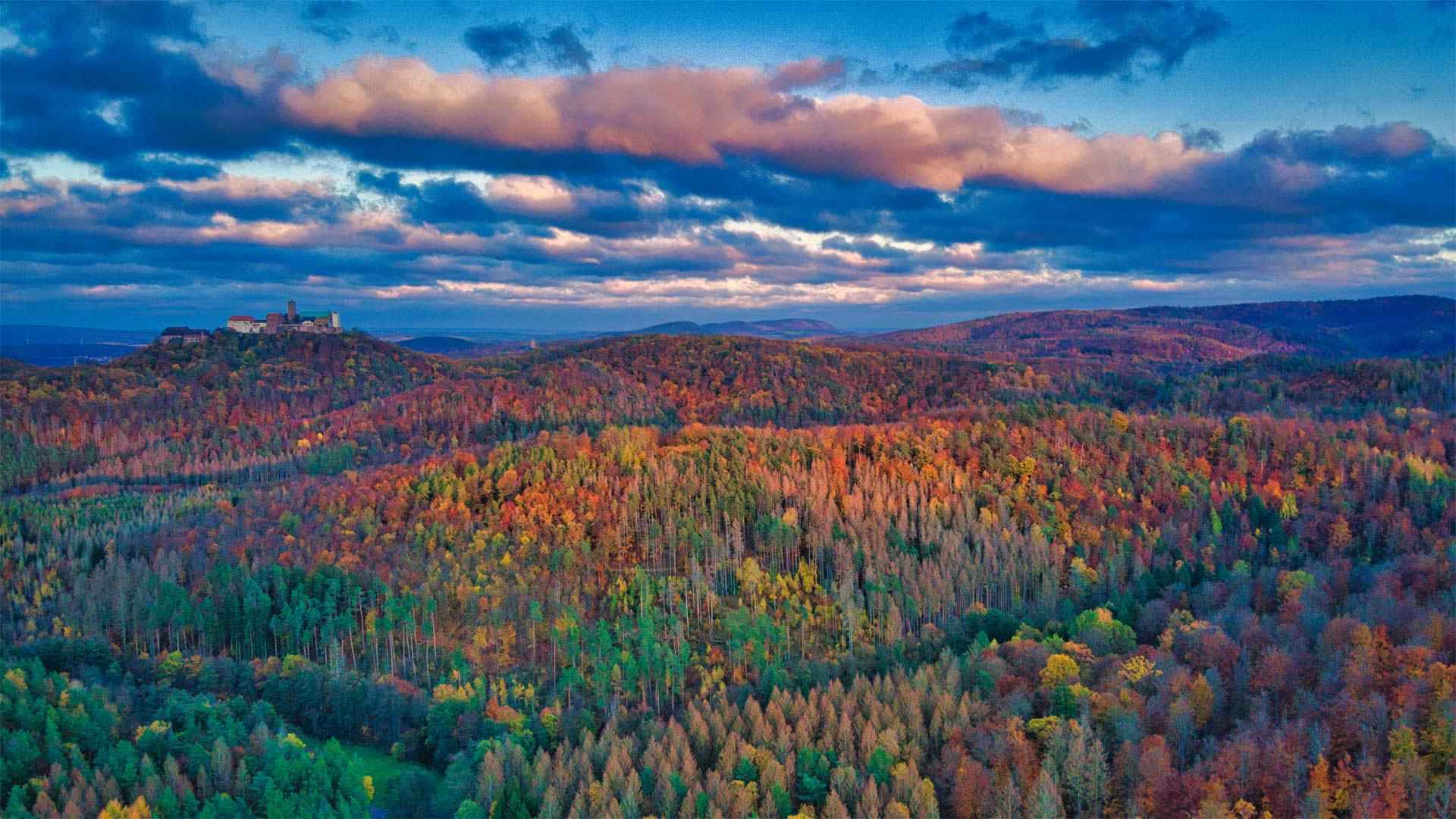
秋天的图林根森林与瓦特堡城堡,德国 Thuringian Forest in autumn with Wartburg Castle, Germany (© ezypix/Getty Images)
等等,这山上得有座城堡! 'Wait, mountain—you shall bear my castle!'
俯瞰德国图林根森林的沃特堡城堡
当你浏览今天德国图林根森林树木变色的照片时,请注意远处的城堡。这就是瓦茨堡,一座建于中世纪的城堡,对有信仰的人来说意义重大。它是图林根天主教圣伊丽莎白的故乡,也是马丁·路德流亡期间将新约翻译成德语的地方。它是该地区最受欢迎的旅游景点,以其典型的中世纪建筑而闻名。
关于沃特堡的命名,有一些巧妙的文字游戏正在进行。”“Warte”是德语中“watchtower”和“wait”的意思传统认为,城堡的创建者惊呼“Warte,Berg du sollst mir eine Burg tragen!”或者“等等,大山,你将承受我的城堡!”看到位置后。注意那句引语中的“berg”和“burg”,它们分别翻译为山和堡垒。因此,在德国将单词拼凑在一起的伟大传统中,沃特堡这个名字应运而生。
如果你对这座城堡不感兴趣,那么素有“德国绿心”之称的图林根森林对游客来说也有其独特的魅力。德国最古老、最受欢迎的长途徒步旅行步道伦斯泰格(Rennsteig)在森林中绵延约110英里。如果你外出徒步旅行,你会注意到该地区总体上很安静,空气清新、无污染。你甚至可能会遇到一些小村庄,这些村庄遍布该地区,以欢迎外来者而闻名。
Wartburg Castle overlooking Thuringian Forest in Germany
As you glance over today's photo of the trees changing color in Thuringian Forest in Germany, make note of the castle in the distance. That's Wartburg, a castle built in the Middle Ages that holds significance to people of faith. It was the home of the Catholic Saint Elizabeth of Thuringia, and also where Martin Luther translated the New Testament into German while in exile. It's the area's most popular tourist attraction and has been recognized for its quintessential medieval architecture.
There's some clever wordplay going on regarding how Wartburg was named. 'Warte' is German for both 'watchtower' and 'wait.' Tradition suggests the castle's founder exclaimed 'Warte, Berg—du sollst mir eine Burg tragen!' or 'Wait, mountain—you shall bear my castle!' upon seeing the location. Note the 'berg' and 'burg' in that quote, which translate to mountain and fortress, respectively. And so in the grand German tradition of mashing words together, the name Wartburg came to be.
If the castle isn't of interest to you, Thuringian Forest, known as the Green Heart of Germany, has plenty of its own charm for tourists. The oldest and most popular long-distance hiking trail in Germany, the Rennsteig, runs for about 110 miles within the forest. If you're out for a hike you'll notice the general quietness of the area and fresh, unpolluted air. You may even happen upon the tiny villages that pepper the area and have a reputation for welcoming outsiders.
一年一度的灯光节期间,奥伯巴姆大桥上的设计方案, 德国柏林 Designs projected on the Oberbaum Bridge during the yearly Festival of Lights in Berlin, Germany (© John MacDougall/AFP via Getty Images)
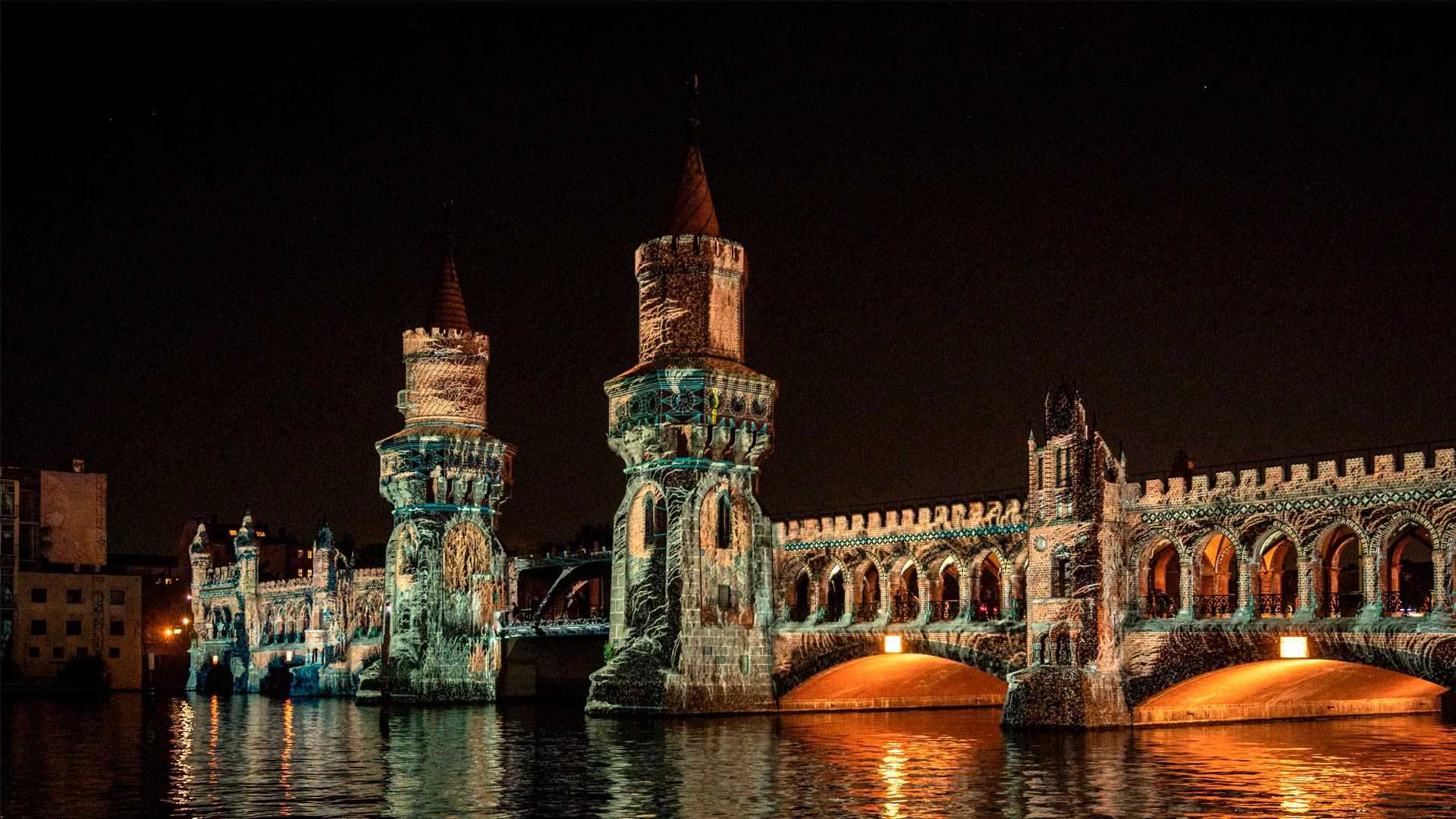
一年一度的灯光节期间,奥伯巴姆大桥上的设计方案, 德国柏林 Designs projected on the Oberbaum Bridge during the yearly Festival of Lights in Berlin, Germany (© John MacDougall/AFP via Getty Images)
新光中的旧桥 An old bridge in a new light
柏林灯光节
双层Oberbaum大桥是柏林最受欢迎的标志性建筑之一。这座有数百年历史的桥曾经连接了两个被柏林墙分隔开的行政区,1961年至1989年,柏林墙在物理上和思想上分隔了东柏林和西柏林。这里的第一座桥建于18世纪,尽管目前的公路和铁路奥伯巴姆是在19世纪末修建的。
它仍然是统一柏林的重要象征,也是该市一年一度为期一周的灯节的标志性建筑,从今天开始。这一国际艺术节已经举办了18年,随着颜色、图案和图像投射到整个城市的建筑上,柏林的建筑和地标都以巧妙的灯光展示方式进行了改造。在这里,我们看到Oberbaum灯火通明,迎接2020年的节日,这与冷战时期大不相同。近30年来,这座桥一直是东柏林和西柏林之间的过境点。随着检查站的安装和历史塔楼的拆除,它成为了铁路线的终点。但在1990年德国统一后,这座桥被重建,并恢复了昔日的辉煌——这对于一座标志性建筑来说是一个合适的命运,它随着它所服务的城市而改变。
Berlin Festival of Lights
The double-decker Oberbaum Bridge is one of Berlin's most beloved and iconic landmarks. This centuries-old span once connected two boroughs separated by the Berlin Wall, the barrier that physically and ideologically divided East and West Berlin from 1961 to 1989. The first bridge in this spot was built in the 1700s, although the current road-and-rail Oberbaum was constructed at the end of the 19th century.
It remains an important symbol of unified Berlin, and a prominently featured landmark in the city's annual, weeklong Festival of Lights, which begins today. The international festival, now in its 18th year, transforms Berlin's buildings and landmarks with artful displays of light, as colors, patterns, and images are projected onto structures across the city. Here we see the Oberbaum all lit up for the 2020 festival—a far cry from its Cold War days. For nearly 30 years, the bridge served as a border crossing between East and West Berlin. It became the end of the train lines as a checkpoint was installed and the historic towers were demolished. But after German reunification in 1990, the bridge was rebuilt and restored to its former glory—a fitting fate for a landmark that has transformed along with the city it serves.
赫努姆的茅草屋顶, 德国叙尔特岛 (© Francesco Carovillano/eStock Photo)
基姆湖上的淑女岛,德国巴伐利亚州 Aerial view of Fraueninsel island in Chiemsee, Bavaria, Germany (© Malorny/Getty Images)
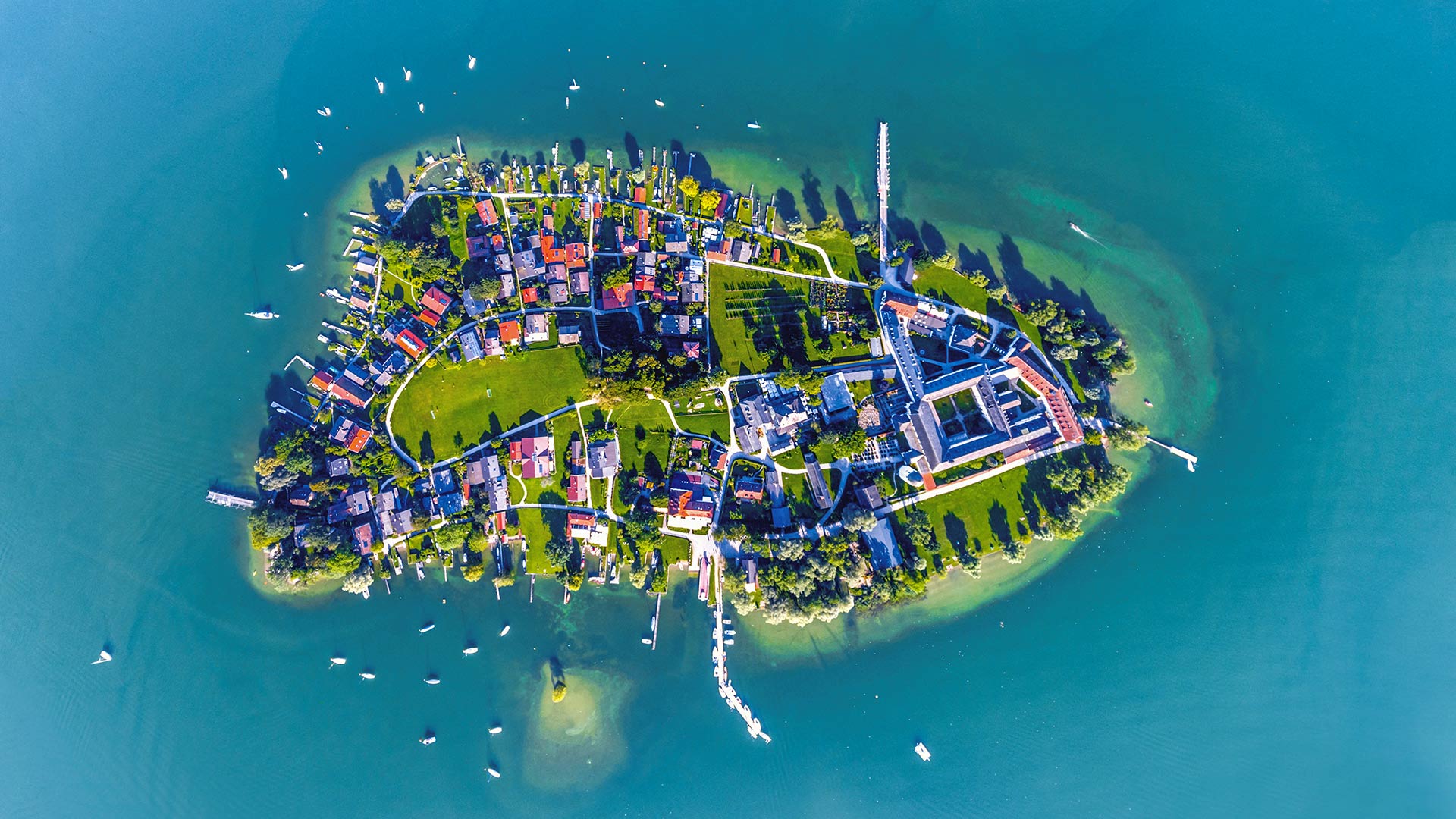
基姆湖上的淑女岛,德国巴伐利亚州 Aerial view of Fraueninsel island in Chiemsee, Bavaria, Germany (© Malorny/Getty Images)
“巴伐利亚海”中的岛屿 Island in the "Bavarian Sea"
Fraueninsel, Chiemsee, Bayern
Just 15.5 hectares in size, the Fraueninsel is still the second-largest island in the Chiemsee after the Herreninsel - admittedly, there are only three inland islands in total, and the tiny Krautinsel as the third in the group is also uninhabited. The car-free Fraueninsel, whose appearance is mainly characterized by the Benedictine monastery of Frauenchiemsee (also known as Frauenwörth), founded in 782, can be reached all year round with the passenger ships of the Chiemsee shipping company.
The only settlement on the Fraueninsel is called Frauenchiemsee. It consists of about 50 houses in which around 250 people live. The name of the place and the island are often used synonymously. Chiemsee, which covers almost 80 square kilometers, is Bavaria's largest lake and Germany's third-largest after Lake Constance and Müritz. In the absence of its own seashore, an affectionate nickname for Lake Chiemsee has emerged among the Bavarian population over time: it is very often referred to as the "Bavarian Sea".
Fraueninsel、切姆西、拜仁
面积只有15.5公顷的弗劳尼塞尔岛仍然是基姆塞岛上仅次于赫雷宁塞尔岛的第二大岛屿——不可否认,总共只有三个内陆岛屿,而作为该群岛第三大岛屿的小克劳蒂塞尔岛也无人居住。无车Fraueninsel的外观主要以建于782年的Frauenchiemsee(也称为Frauenwörth)本笃会修道院为特征,可以通过Chiemsee航运公司的客船全年到达。
关于Fraueninsel的唯一解决方案称为Frauenchiemsee。它由大约50座房屋组成,其中约有250人居住。这个地方和这个岛的名字通常是同义词。基姆塞湖占地近80平方公里,是巴伐利亚州最大的湖泊,也是德国仅次于康斯坦斯湖和缪里兹湖的第三大湖。由于没有自己的海岸,随着时间的推移,基姆塞湖在巴伐利亚人中出现了一个亲切的昵称:它通常被称为“巴伐利亚海”。
